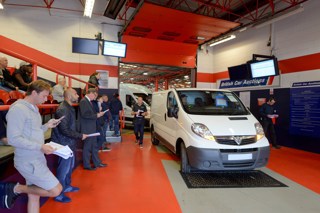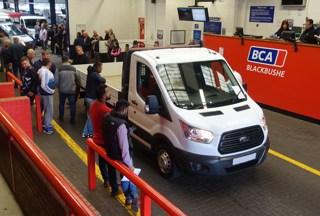Alphabet's downtime prevention guide examines how vehicle providers can contribute to keeping light commercial vehicles on the road.
Having a van unexpectedly off the road, even for a day, may cost you and your business hundreds or thousands of pounds in lost revenue.
Light Commercial Vehicle (LCV) operators in one survey estimated the average cost to a business in terms of unplanned vehicle off-road time (VOR) per day was £727.
Further research, by the Freight Transport Association, suggests that unplanned VOR averages five or six days per vehicle per year on top of an average of three days’ planned downtime for scheduled maintenance and repairs.
Minimising VOR, whether it’s caused by mechanical problems, incident damage or scheduled maintenance could have a potentially dramatic effect on drivers’ productivity and on your fleet budget.
Given the myriad of factors involved, many LCV operators ask “where is the best place to begin?”
Start with your vehicle supplier
Your leasing company may not be the first place you might think of to contact in relation to tackling scheduled and unexpected off-road time, however there is a surprising amount that they can do to help you keep it to a minimum.
Starting with vehicle selection, the level of engagement your vehicle supplier has with your business, the manufacturers and the converters can have a big influence on your vehicles.
Vehicles should be carefully considered and correctly specified in the first place, otherwise it could have a major effect on the level of unplanned VOR.
Acquiring vans that are simply not up to the job in terms of size, payload, specialist equipment or power can place extra strain on the vehicle, which inevitably could lead to more breakdowns.
A good way to identify and pre-empt potential downtime hotspots is to bring all the parties, including drivers, together during the selection and specification process.
Scheduled repairs
Optimising scheduled work on vehicles is another effective tactic in reducing VOR.
Whilst servicing and repairs will always involve a degree of necessary downtime, advances in fleet management systems, mean that it’s often possible for the leasing company to identify due-dates for servicing up to six weeks in advance.
At Alphabet, we will contact our customers, giving them plenty of notice and will give them the opportunity to coordinate servicing and testing on-board items (as necessary) without them incurring separate and additional downtime.
Spare tyre policy
During the early stages of the contract and specification negotiations you may wish to discuss the issue of spare wheels.
Although the trade-offs between load capacity, driver safety and minimising downtime may be hotly debated, carrying a spare does ensure the correct wheel/ tyre combination is always available, should it be required.
If safety is a concern, your leasing company’s contracted roadside service network can carry out wheel changes, getting drivers on their way without having to change the wheel themselves.
Engaging drivers
Drivers have a great deal of influence over downtime levels.
How they drive and how they use specialist equipment determines wear and tear levels, incident rates and unscheduled repairs to equipment and fittings.
Whilst, telematics and ‘traffic light’-style in-cab feedback devices may have a good track record of deterring excessive driving behaviour, they only go so far.
As vehicle specifications and conversions become more complex, it is becoming more important to take time to familiarise drivers with new vehicles.
This may mean interrupting their schedules for a briefing. An alternative approach is to give drivers a ‘virtual handover’.
At Alphabet, we email you and your drivers including a link to a video guide all about their new LCV approximately two weeks before the vehicle is due to be delivered.
If a driver doesn’t have the link for any reason, they can point their phone at a quick response (QR) code in the vehicle to call up a virtual tour of its controls and equipment.
Virtual Handover is designed to limit driver downtime when new vehicles arrive but also to provide subsequent drivers with quick access to information about important safety features and routine maintenance requirements of the vehicle.
Supplying standby vehicles
A major question for every LCV fleet operator is how many vehicles they should operate on their permanent fleet to cover anticipated fluctuations in activity throughout the year.
Running a lean fleet keeps overheads low but leaves operators exposed when vehicles are unexpectedly taken off the road.
For each fleet, there is a different balance to be struck between permanent leased/purchased LCVs and back up rental vehicles.
Your leasing provider, who understands these issues, will take time to analyse your needs carefully before proposing a vehicle funding solution which strikes the optimum balance.
Flexible, medium-term hire packages, which can include maintenance, livery and common vehicle modifications, offer to bridge the gap between contract hire and daily rental.
Standby vehicles, if used, may need to cover several depots in which case the question arises of where they should be located.
At Alphabet, in certain circumstances, we have arranged for a manufacturer to put standby vehicles into hubs across the country to provide customers with immediate cover for unscheduled downtime.
Managing service and repair networks
Once a vehicle has gone into the service or repair centre, the duration of the downtime is largely out of the fleet manager’s hands.
Keeping to service schedules and booking workshop visits well in advance help to keep VOR time down by ensuring the workshop has the necessary parts are in stock.
While-you-wait servicing is increasingly common for LCVs, as are maintenance-inclusive contracts.
However, there may be cases where the most convenient or trusted outlet for you isn’t within their network.
Your leasing provider should be willing to honour your existing supplier relationships as doing so contributes to reducing downtime costs.
This kind of proactive engagement by your supplier can be brought to bear across all areas of downtime – daily rental, repairs, out-of-hours maintenance, etc.
For instance, Alphabet’s repairer network alerts us the moment a customer’s vehicle comes into it.
So even if the customer hasn’t had a chance to tell us that their vehicle is off the road, we will be working with the repairer to get the vehicle back in action again as quickly as possible.
Understanding your business
Ultimately, the more deeply your leasing provider tries to understand your business and the pressures on your fleet, the more effectively they will be able to use their capabilities – proactively and reactively – to reduce and eliminate, where possible, your vehicles downtime.




















Login to comment
Comments
No comments have been made yet.